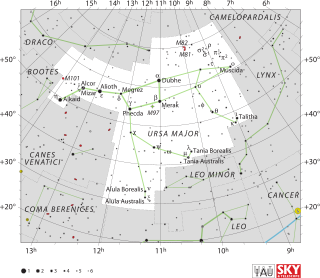Kappa Ursae Majoris (κ Ursae Majoris, abbreviated Kappa UMa, κ UMa) is a binary star in the constellation of Ursa Major. With a combined apparent magnitude of +3.60,[9] the system is approximately 358 light-years from Earth.
| Observation data Epoch J2000.0 Equinox J2000.0 | |
|---|---|
| Constellation | Ursa Major |
| Right ascension | 09h 03m 37.52762s[1] |
| Declination | +47° 09′ 23.4890″[1] |
| Apparent magnitude (V) | 3.56 (4.16 + 4.54)[2] |
| Characteristics | |
| Spectral type | A0 IV-V + A0 V[3] |
| Astrometry | |
| Proper motion (μ) | RA: −36.19[1] mas/yr Dec.: −55.40[1] mas/yr |
| Parallax (π) | 9.10 ± 0.50 mas[1] |
| Distance | 360 ± 20 ly (110 ± 6 pc) |
| Absolute magnitude (MV) | −1.63[4] |
| Orbit[5] | |
| Period (P) | 13,007.2±9.7 d |
| Semi-major axis (a) | 0.18194 ± 0.00025″ |
| Eccentricity (e) | 0.5584±0.0015 |
| Inclination (i) | 109.410±0.066° |
| Longitude of the node (Ω) | 105.641±0.080° |
| Periastron epoch (T) | 50404 ± 12 |
| Argument of periastron (ω) (secondary) | 355.63±0.36° |
| Details | |
| κ UMa A | |
| Mass | 3.79±0.12[6] M☉ |
| Radius | 7.87[7] R☉ |
| Temperature | 9,060[7] K |
| Rotational velocity (v sin i) | 201[6] km/s |
| Other designations | |
| Database references | |
| SIMBAD | data |
The two components are designated Kappa Ursae Majoris A (officially named Alkaphrah /ælˈkæfrə/, a traditional name of the system)[10] and B.
Nomenclature
editκ Ursae Majoris (Latinised to Kappa Ursae Majoris) is the system's Bayer designation. The designations of the two components as Kappa Ursae Majoris A and B derives from the convention used by the Washington Multiplicity Catalog (WMC) for multiple star systems, and adopted by the International Astronomical Union (IAU).[11]
The traditional name of the system is Alkafzah (corrupted to Alkaphrah or El Koprah), from the Arabic القفزة al-qafzah "the leap".[12] (Cf. Alula Borealis and Alula Australis.)
In 2016, the IAU organized a Working Group on Star Names (WGSN)[13] to catalog and standardize proper names for stars. The WGSN decided to attribute proper names to individual stars rather than entire multiple systems.[14] It approved the name Alkaphrah for the component Kappa Ursae Majoris A on 5 September 2017 and it is now so included in the List of IAU-approved Star Names.[10]
In Chinese, 三台 (Sān Tái), meaning Three Steps, refers to an asterism consisting of Kappa Ursae Majoris, Iota Ursae Majoris, Lambda Ursae Majoris, Mu Ursae Majoris, Nu Ursae Majoris and Xi Ursae Majoris. Consequently, the Chinese name for Kappa Ursae Majoris itself is 上台二 (Shàng Tái èr, English: Star of Second Upper Step).[15]
Properties
editBoth components of the binary star are white A-type main sequence dwarfs. They have apparent magnitudes of +4.2 and +4.5.[16] The orbital period of the binary is 35.6 years (13,007.2 days), and the two stars are separated by 0.18 arcseconds.[17] An infrared excess indicates a debris disk with a mean temperature of 165 K is orbiting the primary at a separation of 55.2 AU.[7]
References
edit- ^ a b c d e van Leeuwen, F. (November 2007). "Validation of the new Hipparcos reduction". Astronomy and Astrophysics. 474 (2): 653–664. arXiv:0708.1752. Bibcode:2007A&A...474..653V. doi:10.1051/0004-6361:20078357. S2CID 18759600.
- ^ Eggleton, P. P.; Tokovinin, A. A. (September 2008), "A catalogue of multiplicity among bright stellar systems", Monthly Notices of the Royal Astronomical Society, 389 (2): 869–879, arXiv:0806.2878, Bibcode:2008MNRAS.389..869E, doi:10.1111/j.1365-2966.2008.13596.x, S2CID 14878976.
- ^ Edwards, T. W. (April 1976), "MK classification for visual binary components", Astronomical Journal, 81: 245–249, Bibcode:1976AJ.....81..245E, doi:10.1086/111879
- ^ Anderson, E.; Francis, Ch. (2012), "XHIP: An extended hipparcos compilation", Astronomy Letters, 38 (5): 331, arXiv:1108.4971, Bibcode:2012AstL...38..331A, doi:10.1134/S1063773712050015, S2CID 119257644.
- ^ Hartkopf, W. I.; et al. (June 30, 2006), Sixth Catalog of Orbits of Visual Binary Stars, United States Naval Observatory, archived from the original on 2017-08-01, retrieved 2017-06-02.
- ^ a b Zorec, J.; Royer, F. (2012), "Rotational velocities of A-type stars. IV. Evolution of rotational velocities", Astronomy & Astrophysics, 537: A120, arXiv:1201.2052, Bibcode:2012A&A...537A.120Z, doi:10.1051/0004-6361/201117691, S2CID 55586789.
- ^ a b c Cotten, Tara H.; Song, Inseok (July 2016), "A Comprehensive Census of Nearby Infrared Excess Stars", The Astrophysical Journal Supplement Series, 225 (1): 24, arXiv:1606.01134, Bibcode:2016ApJS..225...15C, doi:10.3847/0067-0049/225/1/15, S2CID 118438871, 15.
- ^ "CCDM J09036+4709AB -- Double or multiple star", SIMBAD Astronomical Object Database, Centre de Données astronomiques de Strasbourg, retrieved 2012-03-26
- ^ Johnson, H. L.; et al. (1966). "UBVRIJKL photometry of the bright stars". Communications of the Lunar and Planetary Laboratory. 4 (99): 99. Bibcode:1966CoLPL...4...99J.
- ^ a b "Naming Stars". IAU.org. Retrieved 16 December 2017.
- ^ Hessman, F. V.; Dhillon, V. S.; Winget, D. E.; Schreiber, M. R.; Horne, K.; Marsh, T. R.; Guenther, E.; Schwope, A.; Heber, U. (2010). "On the naming convention used for multiple star systems and extrasolar planets". arXiv:1012.0707 [astro-ph.SR].
- ^ Allen (1899)
- ^ "IAU Working Group on Star Names (WGSN)". Retrieved 22 May 2016.
- ^ "WG Triennial Report (2015-2018) - Star Names" (PDF). p. 5. Retrieved 2018-07-14.
- ^ (in Chinese) (Activities of Exhibition and Education in Astronomy) 天文教育資訊網 2006 年 6 月 21 日 Archived 2016-03-03 at the Wayback Machine
- ^ Mason, Brian D.; Wycoff, Gary L.; Hartkopf, William I.; Douglass, Geoffrey G.; Worley, Charles E. (2001). "The 2001 US Naval Observatory Double Star CD-ROM. I. The Washington Double Star Catalog". The Astronomical Journal. 122 (6): 3466. Bibcode:2001AJ....122.3466M. doi:10.1086/323920.
- ^ Muterspaugh, Matthew W.; et al. (December 2010), "The Phases Differential Astrometry Data Archive. II. Updated Binary Star Orbits and a Long Period Eclipsing Binary", The Astronomical Journal, 140 (6): 1623–1630, arXiv:1010.4043, Bibcode:2010AJ....140.1623M, doi:10.1088/0004-6256/140/6/1623, S2CID 6030289
